Where do all the siblings go? One of my earliest book memories was of Ida in Maurice Sendak’s Outside Over There taking matters into her own hands to rescue her baby sister, who has been replaced with a changeling (and, in the movies, the well-named Sarah similarly setting off to save her little brother from the clutches of the Goblin King). The Pevensies ruled Narnia together. Meg Murry and her brother Charles Wallace traveled the universe to get their father back in A Wrinkle in Time, their brothers Sandy and Dennys traveled back to biblical times, and all sorts of other adventures befell their family, as well as the other assorted O’Keefes and Austins and their acquaintances. And I adored William Sleator’s Singularity, in which teenage Harry figured out a way to get out from under the shadow of his twin.
All of that drove home what I knew from my own experience: siblings could be maddening, but they were important.
I’ve always been drawn to stories that center family dynamics, and particularly sibling dynamics, whether supportive or just complicated. They’re harder to find in adult fiction (I’m pretending not to see you over there, Lannisters), but often even richer for the nuances that enter the picture. In We Are Satellites I set out to depict siblings who were continually rewriting the relationship between each other, as events external and internal to the family wedged between them. I wanted it all to show over the years: the protectiveness, the frustration, the solidarity shared by the only people who know what it’s like to grow up in a particular household, the perception of fairness and justice through a familial lens. A sibling relationship seemed like the perfect way to show the divisions created by my imagined Pilot technology. I couldn’t have done that without great examples like these books.
Here are five more adult SFF books built around a rich, gooey, sibling core.
The Once and Future Witches by Alix E. Harrow
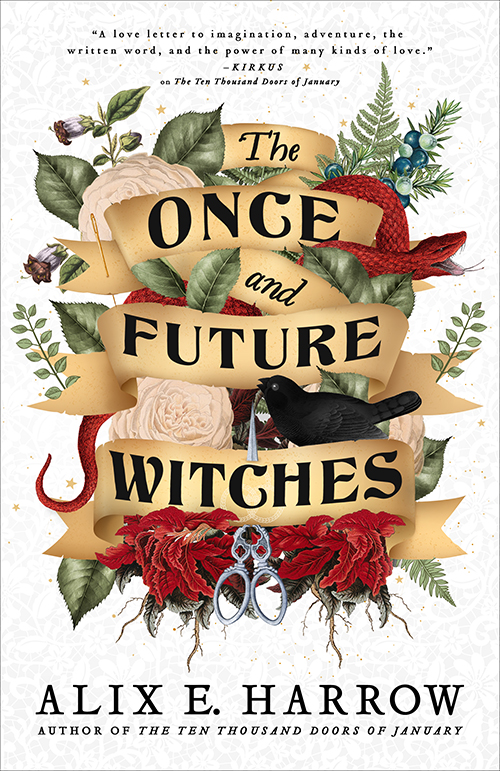
Three estranged sisters in a historical alternate United States find themselves in the city of New Salem after years apart, drawn together reluctantly by the magical threads that still bind them. They have longstanding and well-founded issues with each other, which have only festered and grown over their years apart. In order to work together, they have to learn to communicate, to understand, to forgive, and to recognize each others’ differences and strengths. These are real sibling relationships, fraught, lived in, drenched in personal history. As one of three sisters (and the daughter of one of three sisters) I finished this book and immediately bought it for my sisters and my mother.
The Black Tides of Heaven by Neon Yang
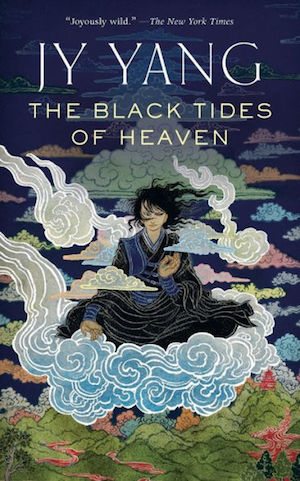
This is one of a pair of twin novellas about the twin progeny of the Protector. Mokoya and Akeha are sent by their autocratic mother to be raised in a monastery, and as they grow into adulthood, they find themselves on opposite sides of a rebellion. Mokoya stays, her power useful in supporting her mother’s Protectorate, while Akeha flees and takes up with the Machinists’ cause. The twins’ relationship, their different powers, their confusion as they watch each other make choices that they don’t themselves understand, are all at the emotional core of this powerful novella.
Beggars in Spain by Nancy Kress
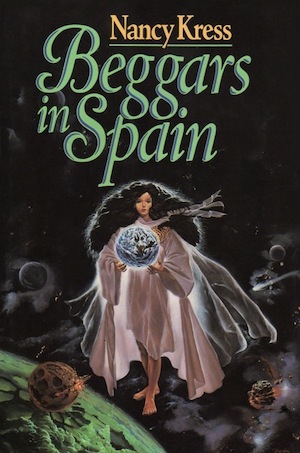
Alice and Leisha are fraternal twins with one huge difference: Leisha has been genetically modified to be one of a growing number of Sleepless children, and her sister has not. Leisha has all that the Sleepless modification confers, including longevity, productivity, intelligence, and good health, and is doted on by their father as the child he designed, while Alice is in every way the ordinary daughter their mother had hoped to have. From the start, they are each other’s playmates, but they know the differences: Alice gets cranky and has to go to bed, and that’s when Leisha’s tutors come in for the night. As they get older, their relationship gets complicated. Leisha craves connection with her sister, but Alice just wants to be normal, and is embarrassed by the attention Leisha gets. Leisha even saying the word “twin” to describe them upsets Alice. Leisha seeks out her Sleepless peers, while Alice deliberately gets pregnant, rejects their longstanding plans, and leaves to make her own way in life. The book takes place over most of a century and moves on to other protagonists and the larger societal repercussions of the Sleeper/Sleepless divide, but it’s the fierce, contentious sibling relationship that has stayed with me in the years since I read the book.
Brothers in Arms by Lois McMaster Bujold
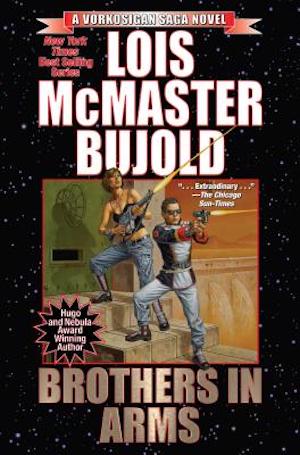
Miles Vorkosigan was raised as an only child. It wasn’t until he was well into adulthood that he met his brother Mark. Mark was in fact Miles’ clone, created by a terrorist as part of a long-game plot to replace Miles, assassinate his father and the Emperor, and ascend the imperial throne. Starting in Brothers in Arms, and continuing through a half-dozen other books in the Vorkosigan saga, Miles and Mark sort out their relationship to each other and what each other’s existence means to their family. (There’s also another great sibling relationship between the Koudelka sisters, and Miles’ close cousin, Ivan.)
We Are All Completely Beside Ourselves by Karen Joy Fowler
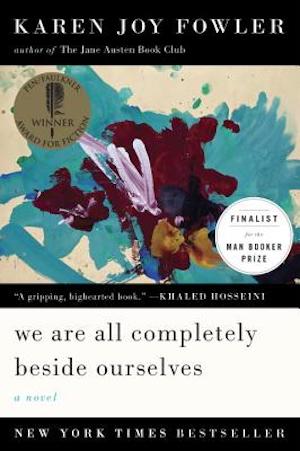
I think the statute of limitations on spoilers is up, but I still feel like I shouldn’t spoil the central conceit of the book. I’m also not sure if it even counts as science fiction, but there’s a central what if? that makes me feel like I can count it, even if it isn’t entirely science fictional, and it was nominated for the Nebula. That central what if relates to Rosemary and her unusual sister Fern and their relationship. That relationship infuses every aspect of Rosemary’s life, and is present throughout the decades recounted in the book, even long after Fern is no longer in the picture. Both her presence and her absence paint the picture of what Rosemary has lost. Gorgeous and heartbreaking.
Sarah Pinsker is the author of Nebula-winning novel A Song For A New Day, new novel We Are Satellites, and 50+ works of short fiction. She lives with her wife and dog in Baltimore, too far away from her sisters.










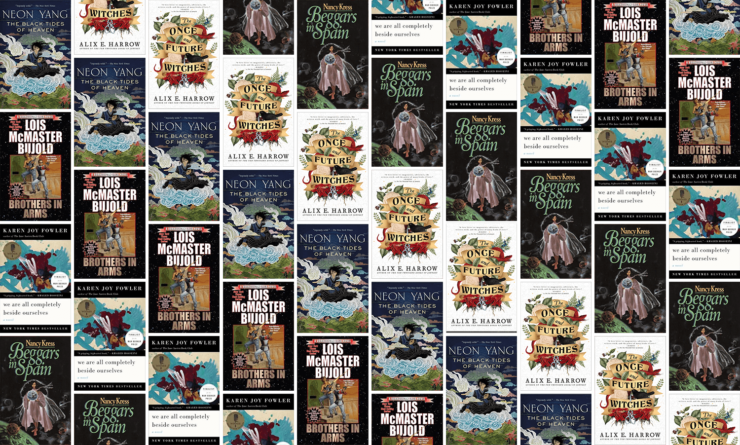
A significant (though not quite “core”) part of Cate Glass’s Chimera series is an older sister raising her younger brother. It gets the most emphasis in the first book and is my favorite aspect of the series.
It’s nice to see the Koudelka sisters get a reference. I would love, love, love LMB to take us for a visit with them, especially, Delia, who seems to gave opted for the staid and safe route as a “neo-Vor-class Matron” (having not married a Vor, but still I assume placed very high in the societal echelon).
The chosen one orphan trope has done a lot of harm to the sibling narrative, and the found family rather than the biological family has replaced it. Hence, Harry Potter with Ron, Hermione, and the Weasleys, and Billy Batson’s foster family in SHAZAM!
I normally scroll back over my reviewed list of books to find good examples to share in this type of post but didn’t find the first example of the sibling narrative in the last 12 months. At best, an older brother was the McGuffin to be rescued. That’s just depressing.
An important part of Megan O’Keefe’s Velocity Weapon and its sequel Chaos Vector is the relationship between siblings Sanda and Biran Greeves.
A recent book that stands out is Middlegame by Seanan McGuire.
One title that comes to mind for me is Heinlein’s “Time for the Stars” (1956). The young hero and his twin brother are recruited for a future space program. They are part of a cadre of twins and triplets who have been found to have a telepathic connection to their siblings. One brother will go to space and the other stays on Earth. The starships cannot break the light speed limit but the telepaths can communicate in real time.
Of course, the first question is who goes and who stays? Who has the adventure of going to the stars and who stays home? And what does it do to the twin brothers relationship when one grows old while the other one, thanks to the time warping effects of traveling at near light speed, does not?
Fortuna and the sequel Memoria by Kristyn Merbeth showcase a family space crew of siblings.
I love the siblings in the Liaden books by Sharon Lee & Steve Miller, particularly Er Thom & Daav who have to navigate sibling affection with a fealty dynamic in the prequels, and Val Con & Theo in the later books who meet eachother as adults and can’t quite settle how they relate to eachother. Plus the rest of this delightfully interwoven expanding family of Korval.
Some books have interesting sibling dynamics that are discovered over the course of the series, including a discovered and then deepening tie in Butcher’s Dresden Chronicles and the very odd ties in Brust’s Vlad Taltos books. A fun short piece is Brandon Sanderson’s novella Firstborn, where the main character is the clone of the universe’s greatest military leader and … can’t… quite…achieve the same types of successes. Not a direct inter-personal sibling relationship but a strong virtual one that pays off by the end.
A Wrinkle in Time comes to mind.
Maybe it’s too dated and outre here, but Roger Zelazny’s Chronicles of Amber, beginning with Nine Princes in Amber (1970), amounts to a multi-sibling free-for-all with a succession squabble at its heart. Competing, conniving, and occasionally cooperating with each other, the princes and princesses of Amber run amok through a spectrum of realities until they bump headlong into the other branch of the family.
Robert Reed’s “Sister Alice” series has families of thousands of cloned siblings.
am I really the first to mention the Wiggins kids in Orson Scott Card’s Enderverse?
Mia Grant’s Newsflesh trilogy, starting with FEED, showcases bloggers Georgia and Shaun Mason as they provide political coverage while fighting zombies. Mia Grant is a pen name for Seanan McGuire.
Let’s not forget Peter and Valentine Wiggin (sad that Peter got his own book, but Valentine didn’t). Those family dynamics shaped Ender (Andrew) more strongly than the parents did.
Guess I am old school fantast, but Caramon and Raistlin Majere always had a complicated relationship.
Randy Henderson has a series of three books (with hopefully more to come) – The Family Arcana. The third book in particular – Smells Like Finn Spirit – gets deep into the complex relationships of Finn and his siblings.
Speaking of Heinlein, there are the Unheavenly Twins, Castor and Pollux Stone from The Rolling Stones (1952).
More Urban Fantasy than sci fi but Rob Thurman has some of the best and most realistic sibling relationships in her books. Niko and Cal Leandros come to mind first of course. They have the kind of complicated relationship that any brothers with terrible (and I REALLY mean terrible) parents have, but there is no doubting how much they love one another. The series really focuses on the struggle of resentment and guilt for that resentment when one child basically raises the other, and the co-dependance of a man who made his little brother’s health and safety his life’s purpose and a little brother who never has the chance to discover who he is without his brother’s protection.
The brothers would do anything for one another and woe be unto anyone who would hurt one of them, but that doesn’t stop Cal from embarrassing Niko in front of the woman he likes, or Niko from making his little brother eat the most disgusting health food he can find… pretty much exactly like my relationship with my 3 sisters. Except, you know, without ancient horrors trying to kill or kidnap one of us.
I am reading through PC Hodgell’s Kencyrath series, so of course I thought first of Jamethiel and Torisen (not to mention the first Jamethiel and Gerridon).
Revenger, Shadow Captain, and Bone Silence by Alistair Reynolds features sisters as the protagonists.